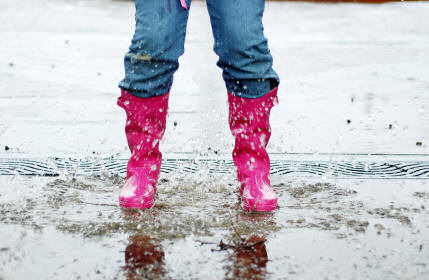Seattle Temperatures by Month

The notoriously rainy, dreary winters in Seattle can be jarring, so if you’re going to the city between November and March, don’t forget your raincoat and galoshes. Seattle’s rainy season is generally expected between January and May and October and December. The region gets over 65 percent of its rainfall during winter, which doesn’t give too many chances for clear days. In fact, the average yearly precipitation is 37 inches and rain averaging 50 percent of the time.
If you’re a snowboarder or skier, the winter months are the best time to go, since the mountains to the east get quite a bit of snow, which typically starts in late October. Most ski areas open in mid November, and there are many that are only a few hours from downtown Seattle. The eastern mountains have a drier climate as well, making the snow not as wet as the more humid mountains in the west.
While the winter rains can get ominous, the result in the springtime is an almost impossibly bright green landscape dotted with flowers everywhere. On the sunny days in April and May you’ll see people filling up the outdoor cafes on the piers, picnic tables, and soaking up the sunshine on the houseboat decks on Lake Union and quickly forgetting it ever rained in the winter. At the first signs of sunshine you’ll see office workers dodging work to soak up the long awaited sun and making any excuse to stay outside. But the rain shouldn’t stop you from doing any of your planned activities, as long as you have rain gear on hand. We’ve compiled a list of our favorite rainy day activities in Seattle so you can have an amazing trip, regardless of the weather.

Want to make money in Seattle? Just sell sweatshirts at any tourist attraction. This sure isn’t Hawaii and the weather can vary by neighborhood and time of day. The rain Seattle is famous for ranges from a misty drizzle to full downpours. The misty drizzle is often more common in frequency, but low in inches of precipitation as shown by the chart below. Here is a chart to help plan your trip of average temperatures – both minimum and maximum, and rainfall.
If you’re looking for warm, sunny weather, the summer months are your best bet. Check out our data below – it averages out the last 50 years!
| Month | Avg High Temp | Avg Rain (inches) |
| January | 46 | 6 |
| February | 50 | 4 |
| March | 53 | 4 |
| April | 58 | 2 |
| May | 65 | 2 |
| June | 69 | 1 |
| July | 75 | 1 |
| August | 74 | 1 |
| September | 69 | 2 |
| October | 60 | 3 |
| November | 52 | 5 |
| December | 47 | 6 |
Because of Seattle’s famous coffee culture and vibrant music scene, there are plenty of things to do if you happen to get caught in the infamous Seattle downpours. The excellent coffee and one of your warmer sweaters will get you through the rainy days and the local brew and concerts on the rainy nights.
If you absolutely hate the rain and want to see Seattle in good weather its best to go during the high season in the summer months. It hardly ever rains in June, July, or August, and the days are so sunny and clear you’ll wonder why they say it rains all the time here. You’ll find everybody outside kayaking, sailing Puget Sound, walking, running, and sitting in the afternoon sun. The summer temperatures are usually a pleasant 75, although there are occasional heat waves that bring it up to the high 80s or low 90s.
The best way to pack is to bring layers because you never know when a rainstorm or a sudden drop in temperature may happen. This unpredictable weather is due mostly from the hilly terrain’s convergence zones. And if you want to blend in with the locals don’t bother with an umbrella because you will stand out like a tourist who is too soft for the Seattle air. Plus, after awhile you get used to the drizzle.
By: Jesse Whitman, Copyright SFTRAVEL LLC
